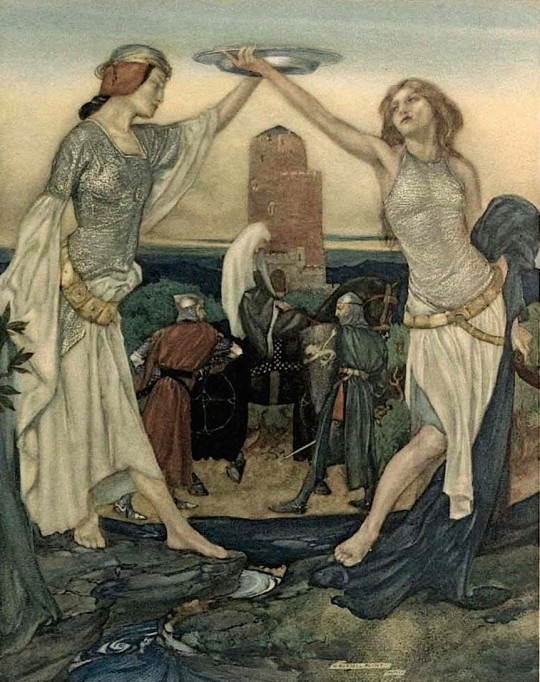#scottish kings
Text
14th December
King James V

James V (reigned 1513-1542). Source: The Royal Family website
On this day in 1542, James V of Scotland died. He was a popular monarch and his reputation as an all round good guy was much enhanced by a legendary tale of his walking among the common folk. James regularly went on solo trips around the country, calling himself The Goodman of Ballengeich, in order to better understand the lives and opinions of his subjects. On one such occasion he was attacked by four footpads but was able to fight them off thanks to a passing farmer, Jock Howieson, who came to his aid. Jock bathed the king’s wounds and then, at his request, took him to Edinburgh where the Goodman claimed he was employed as a servant at the royal palace at Holyrood. Once there, James told Jock he would give him a guided tour of the palace in recognition of the farmer’s heroism.
The king took the fascinated Jock into the inner sanctums of the palace and told him that the king was in residence and that he would recognise him because he would be the only person in the room with a hat still on his head. When James and Jock entered a room full of courtiers, the farmer noticed that hats were doffed and he and the Goodman were the only people whose heads remained covered. The penny dropped and Jock fell to his knees before the king who laughed out loud and granted his rescuer his fondest wish - to be granted the land on which his farm stood.
The encounter feels so much like a fairy story, it may actually be true.
1 note
·
View note
Text

King Arthur's Tomb, from William Morris' The Defence of Guenevere and Other Poems by Jessie M. King (1904)
#jessie m. king#art#illustration#art nouveau#1900s#1900s art#vintage art#vintage illustration#vintage#scottish artist#scottish art#poetry#poetry art#mythology#arthurian legend#king arthur#guenevere#classic art
2K notes
·
View notes
Text








HAPPY BIRTHDAY, EWAN MCGREGOR!
March 31st, 1971 (Perth, Scotland)
#emcgregoredit#dccastedit#swcastedit#ewan mcgregor#flawlessgentlemen#mensource#dilfgifs#dailymenedit#usermullet#userconstance#userkk#usermelanie#hbd to the scottish king!!!! <3#gifs*#**
1K notes
·
View notes
Text
Soap MacTavish.
Coming into the living room freshly showered, still glistening in nothing but those sexy grey sweatpants hanging so perfectly on his slutty waist.
Walking like a boss straight to the freezer to grab a carton of ice cream, muttering he got 'too hot n'th shower, need to cool off' while he shovels a spoonful into his mouth.
And you just sit on your couch. Dumbfounded.
Wondering how the fuck the majestic masterpiece that is John 'Soap' MacTavish somehow ended up in your life, half naked and eating ice cream straight from the carton in your kitchen like the Scottish king he knows he is.
#ice cream eating Scottish king#just glistening in your kitchen#soap squad™️#og and reboot#the brainrot of Captain MacTavish#johnny soap mactavish#john soap mactavish#soap mactavish#john mactavish#im slightly drunk#can you tell?#call of duty#cod
835 notes
·
View notes
Text

Jessie Marion King (1875-1949), 'Her Face Was Veiled'.., “A House of Pomegranates” by Oscar Wilde, 1915
Source
#jessie m. king#jessie marion king#scottish artists#oscar wilde#A House of Pomegranates#art nouveau#vintage illustration#vintage art
313 notes
·
View notes
Text






Dunnottar Castle, "fort on the shelving slope" is a ruined medieval fortress located upon a rocky headland on the north-eastern coast of Scotland, about 2 miles (3 kilometers) south of Stonehaven. The surviving buildings are largely of the 15th and 16th centuries, but the site is believed to have been fortified in the Early Middle Ages. Dunnottar has played a prominent role in the history of Scotland through to the 18th-century Jacobite risings because of its strategic location and defensive strength.
Dunnottar is best known as the place where the Honours of Scotland, the Scottish crown jewels, were hidden from Oliver Cromwell's invading army in the 17th century. The property of the Keiths from the 14th century, and the seat of the Earl Marischal, Dunnottar declined after the last Earl forfeited his titles by taking part in the Jacobite rebellion of 1715. The castle was restored in the 20th century and is now open to the public.
The ruins of the castle are spread over 1.4 hectares (3+1⁄2 acres), surrounded by steep cliffs that drop to the North Sea, 160 feet (50 meters) below. A narrow strip of land joins the headland to the mainland, along which a steep path leads up to the gatehouse. The various buildings within the castle include the 14th-century tower house as well as the 16th-century palace.
(source)
607 notes
·
View notes
Text

stu in edinburgh, 2024 europe tour. pencil and ballpoint pen on paper.
#reference photos by ME cos i was THERE BABEY#seeing him run out in that kilt was truly the jaw drop moment of all time#ugh greatest show of all time they played magma lord of lightning hell motor spirit flamethrower gaia mind fuzz UGH AAAUGHH#take me BACK bro#who remembers date with me scottish mate....... aaanyway#king gizzard & the lizard wizard#king gizzard#kgatlw#kglw#stu mackenzie#fan art#my art#art#king gizzard fanart#my posts
179 notes
·
View notes
Text
me personally I like to imagine Claudius killed his brother in the first place because he came across a group of witches who told him that he’d be king someday and he took it from there. I also like to imagine that there’s just a coven of witches that hangs around Europe telling unstable and violent men in positions of power that they’re soon to be king just to see what happens. they’re pot stirrers
328 notes
·
View notes
Text
I know that depictions of Scottish people in media are hardly the most egregious or damaging in the grand scheme of things of “let’s fuck up understanding of a culture for funzies”, but I will never be over Kingsman 3’s utterly bizarre decision to have the grand reveal of their villain be that he’s Scottish and upset about the Highland Clearances.
He even wears tartan trousers for fuck’s sake, something I could not take in anyway seriously because those are what my headteacher wore to school events.
What’s your specific examples?
99 notes
·
View notes
Text
The King of the Cats
A fun little folklore plot that shows up in Scotland, Ireland and England is the death (and succession) of the King of the Cats.
The story usually begins with a man being told, either by a cat or a disembodied voice, to inform a certain person that another person has died. Both persons are called by their full name, usually strange names, which are unfamiliar to the protagonist. When the protagonist comes home he tells what a strange thing happened to him. Upon overhearing the message the house cat jumps up and declares that they are now the King of the Cats, immediately leaving never to be seen again.
There are other versions of this type of story, more widespread over Europe, where there cat may be a fairy or troll in disguise. Or there isn’t a cat at all, but a house gnome or elf instead, and the announced death is that of a relative or enemy. But it’s the concept of a King of the Cats who can be succeeded by a cat that is currently an ordinary house cat, that delights me so.
The name of the deceased Cat King and the successor differ per story:
In this version from Lancashire they are called Doldrum and Dildrum.
In Joseph Jacobs’ version, which is an amalgamation of several English variants, they are called Tom Toldrum and Tom Tildrum. (This version even includes a whole feline funeral procession.)
The oldest recorded version of this story is from the Beware the Cat by Baldwin (written 1553, published 1561). Only the dead cat in question (Grimalkin) is never called the king of the cats, and the cats receiving the message (Puss) is a female cat, who is sad to leave her home.
In this Scottish version the successor is unnamed, but the dead Cat King is called Old Peter.
The stories sadly do not say a lot about what it means to be the King of the Cats, apart from some mentioning a sceptre and crown, but Lady Wilde does have something to say about him in her Ancient Legends, Mystic Charms, and Superstitions of Ireland (1888):
A most important personage in feline history is the King of the Cats. He may be in your house a common looking fellow enough, with no distinguishing mark of exalted rank about him, so that it is very difficult to verify his genuine claims to royalty. Therefore the best way is to cut off a tiny little bit of his ear. If he is really the royal personage, he will immediately speak out and declare who he is; and perhaps, at the same time, tell you some very disagreeable truths about yourself, not at all pleasant to have discussed by the house cat.
Her second example has a content warning for animal cruelty, so I will put it underneath a cut, but it does imply that the Cat King might be capable of reincarnation…
A man once, in a fit of passion, cut off the head of the domestic pussy, and threw it on the fire. On which the head exclaimed, in a fierce voice, "Go tell your wife that you have cut off the head of the King of the Cats; but wait! I shall come back and be avenged for this insult," and the eyes of the cat glared at him horribly from the fire.
And so it happened; for that day year, while the master of the house was playing with a pet kitten, it suddenly flew at his throat and bit him so severely that he died soon after.
#fuel for my sister <3#folklore#cats#cat#king of the cats#cat king#english folklore#irish folklore#scottish folklore
128 notes
·
View notes
Text
Time Travel Question : Murder and Disappearance Edition I
Given that Judge Crater, Roanoke, and the Dyatlov Pass Incident are credibly solved, though not 100% provable, I'm leaving them out in favor of things ,ore mysterious. I almost left out Amelia Earhart, but the evidence there is sketchier.
Some people were a little confused. Edward V and Richard of Shrewsbury are the Princes in the Tower.
#Time Travel#Famous Murders#Jack the Ripper#La Bete du Gevaudan#Gandillon Family#Werewolves#William Rufus#King William II#Edward V#Richard of Shrewsbury#French History#English History#Early Modern Europe#Victorian England#Lord Darnley#Mary Queen of Scots#Scottish History#Amy Robsart#Lord Dudley#The Sodder Children#The Somerton Man#Australian History#Prime Minister Harold Holt#Elizabeth Short#The Black Dahlia
504 notes
·
View notes
Text

Alan King (British, 1946-2003), Study for a Juggler. Mixed media on board, 12 x 9 in.
206 notes
·
View notes
Text


Illustrations from Thomas Malory's Le Morte d'Arthur by William Russell Flint (1911)
#william russell flint#art#illustration#golden age of illustration#1910s#1910s art#vintage art#vintage illustration#vintage#scottish artist#scottish art#books#book illustration#mythology#arthurian legend#king arthur#le morte d'arthur#thomas malory#classic art
942 notes
·
View notes
Text

Macbeth and the Three Witches by Francesco Zuccarelli
#macbeth#three witches#art#banquo#francesco zuccarelli#shakespeare#william shakespeare#prophecy#scottish#england#scotland#britain#witch#witches#supernatural#landscape#storm#stormy#storms#thunder#lightning#thunderstorm#thunderstorms#night#castle#castles#king#tragedy#sky#clouds
96 notes
·
View notes
Text

#id in alt text#cait sith#final fantasy vii#final fantasy 7#ffvii remake#ff7 remake#final fantasy 7 remake#final fantasy vii remake#ffvii rebirth#final fantasy vii rebirth#ff7 rebirth#celtic#celtic mythology#irish mythology#scottish mythology#The king of the cats#reeve tuesti#Cat-sidhe#Fairy Cat#cat-sìth
98 notes
·
View notes
Text

Jessie Marion King (1875-1949), 'Ode to Night' (Shelley), 1926
Source
#jessie marion king#jessie m. king#scottish artist#Percy Bysshe Shelley#vintage illustration#vintage art#art nouveau
132 notes
·
View notes